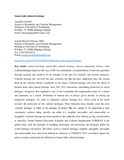Immovable cultural heritage
Abstract
Cultural heritage expresses the way of life of a community over generations. It answers questions through research and archives of the remains of the past for scientific and historic purposes. Cultural heritage has survived the past centuries but the previous adaptation may not sustain them in the extreme climate conditions in the future. Cultural heritage sites face the threat of hazards more than natural heritage sites. The 1972 convention concerning protection of world heritages recognizes that mankind is one of the invaluable and irreplaceable assets of a nation and humanity as a whole. Reduction of human loss is always given priority in setting up mitigation strategies. ,In order to minimize cultural heritage loss, efforts need to be made towards the protection of the cultural heritages. Most literature have broadly used the term ‘cultural heritage’ to refer to all remains of history that are valued to be important to host community without being specific on either it’s tangible (moveable and immovable) or intangible. Cultural heritage has been quoted as the umbrella term without giving consideration to specifics. United Nations Education Scientific and Cultural Organization (UNESCO) is the global body with the mandate of building, promoting and protecting the heritages under the world heritage convention. The terms such as cultural heritage, tangible, intangible, moveable and immoveable have only been defined in reference to UNESCO 1972 convention, hence the need to clearly understand the definition of immovable cultural heritage.
URI
https://doi.org/10.4337/9781800377486.immovable.cultural.heritagehttps://www.elgaronline.com/view/nlm-book/9781800377479/b-9781800377486.immovable.cultural.heritage.xml
http://hdl.handle.net/123456789/5516

